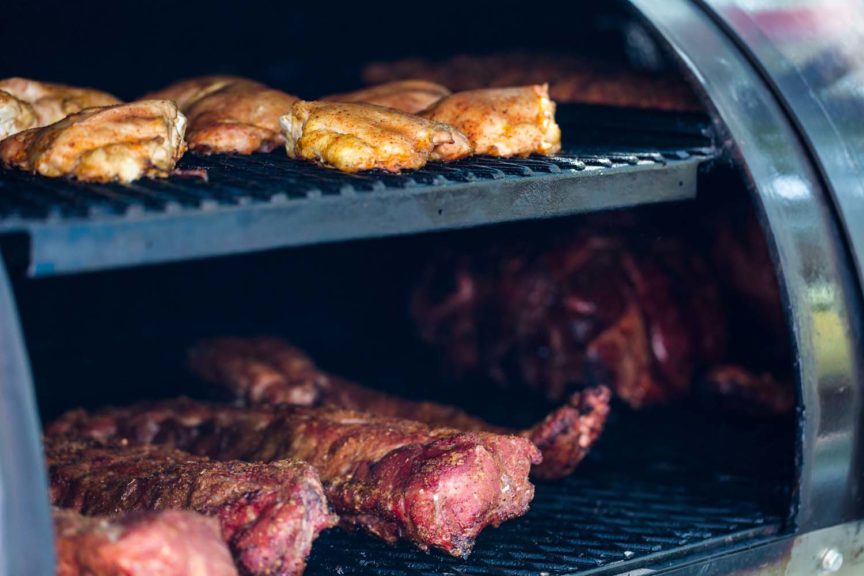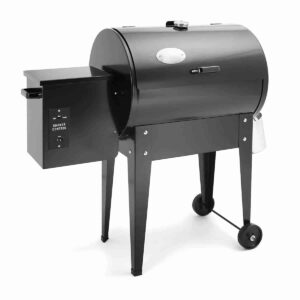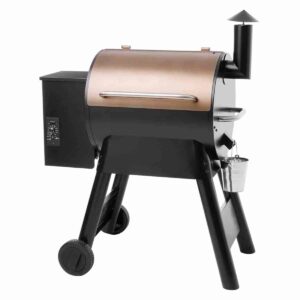Smoking is a delicate cooking art that requires a lot of patience and skill. However, with the right know-how and practice, it becomes quite easy to do. Stick around to see our ten expert tips for smoking meat!
Barbecuing, Grilling, and Smoking Meat
Many people associate grilling, barbecuing, and smoking to mean the same thing, but they’re actually quite different strategies for cooking meat.
- Grilling – Grilling involves cooking meat over high heat under a short amount of time. The result is a very tender and juicy cut contained by a thin crust around the outside.
- Barbecuing – Barbecuing takes a little more time compared to grilling because the process requires you to cook the meat over low, indirect heat.
- Smoking – With smoking, meat is put in a barbecue, grill, or smoker for several hours under low-heat, smoky conditions. The smoke penetrates through the food and results in a distinct smoky taste when finished.
10 Expert Tips for Smoking Meat
Is this your first time smoking meat on the grill? Ready to become more than a smoking novice? Follow these ten tips to ensure that your food comes out looking, smelling, and tasting perfect!
1. Choose your grill wisely.
You don’t have to own a traditional wood smoker in order to create a delicious smoked meal. In fact, you can smoke meat on a charcoal or gas or propane grill, too!
If you are looking for a smoker. We recommend this Lp Vertical Smoker by Pit Boss. (Link to Amazon)
2. Use a good burning material.
There are a couple of burning sources you can use to smoke meat: wood and charcoal. Check out these options for the longest and hottest burning charcoal.
Wood Chips, Chunks, & Pellets
Wood is the more common material used for smoking meat. Both wood chips, pellets, and larger chunks or blocks are equally useful for this process.
However, bear in mind that when you decide to use wood for smoking that you’re aware of how different types of wood produces different flavors; the kind of wood you choose can affect the outcome of the taste of your food when it’s done smoking. The following table shows the wood types commonly used in smoking meat, the flavor they produce, and examples of meats to use with the wood type.
(Click on each wood type to be taken to Amazon to check the price. In many case you can order these and have them delivered the next day!)
Wood Type | Description | Flavor Outcome | Best Meat to Smoke |
This wood type is excellent for smoking beginners; it is most commonly used for basic smoking. | Has a standard, smoky taste. | Lamb, beef, brisket, and sausages | |
A versatile wood type that can be used to smoke many kinds of meats. | Used the right way, hickory produces a sweet, savory, and hearty flavor. However, too much hickory will result in a more bitter taste. | Most red meats and poultry; large rib cuts and pork shoulders | |
A subtle smoking wood type compared to other types. | Can produce a light, sweet smoke flavor. | Poultry, game foul, and pork | |
A very hardy wood that is more often used to add flavor in grilling than smoking. | Produces a strong and intense smoky flavor. | Red meat | |
More of a sweet type of wood that is often used with a harder wood to balance the flavor. | Produces a rich, sweet, and nutty flavor. | Briskets, roasts, and ribs | |
Another subtle smoking wood that takes additional time to permeate the meat. | Has a light, sweet flavor, similar to Maple. | Chicken, wild foul, pork | |
A light, subtle smoking wood commonly used with smoking fish. | Similar to Maple and Apple in that it offers a mild sweet flavor. | Fish–more commonly salmon and other Pacific Northwestern types | |
This wood is also mild and is often combined with other hardwoods for complimenting flavors. | Has a light, fruity flavor. | Chicken, turkey, and ham |
Source: Chad’s BBQ
Charcoal
If you decide to use charcoal, you will not have the flexibility to choose your meat’s flavor as much as with wood, but alternatively, you can place an aluminum pan filled with an apple cider vinegar and water mix or other fruit juice alternative to create the flavor you’re looking for.
Some grillmasters like using both wood and charcoal to smoke; charcoal is placed on the bottom of the grill to produce heat, while the wood is placed over the charcoal to produce the smoke and flavor.
3. Use a dry rub.
Smoking is more effective if you use a dry rub to prepare your meat rather than a wet marinade; if the meat is wet, it typically does not develop the flavorful, caramelized crust expected out of a dry rub. Checkout this article for great rub and seasonings recipes.
In addition, if you do use a marinade versus a dry rub, you will need to be extra careful about making sure the meat stays hydrated as it smokes; once the moisture burns off, the grill’s temperature can increase very fast and can start to burn the meat instead of smoke it.
4. Use low heat settings.
When you’re smoking meat, make sure you have the grill set at a low heat (around 220 degrees). Avoid adding too much wood or charcoal to the barbecue as the meat could end up with a more bitter taste from over-smoking. You just need to have enough wood or charcoal to maintain a slow flow of smoke.
The meat should also be away from the grill’s flame at all times; if it is directly above the fire, the juices can end up burning, creating a black smoke that creates an undesirable burnt flavor. If needed, build your initial fire on one side of the grill and place the meat on the other side to prevent this.
Featured Grill
Fuego F21C-H Element Hinged Propane Gas Grill
• Upgraded 22,000 BTU/hr. dual zone burner system
• 500F in just 5 minutes
• Compact 21″ x 21″ footprint, perfect for the small patio/balcony.
• 346 sq. in. cast iron grilling grate
5. Keep the moisture in.
The fluctuating temperatures during the process of smoking could potentially dry out the meat, especially if you plan on using charcoal. It is imperative to make sure that there is constant moisture present as the meat cooks. There are several ways to do this:
- Provide moisture. All you need is a spray bottle, apple cider vinegar, and water! Fill up the spray bottle with equal parts vinegar and water and lightly spritz the meat every few hours to keep it from getting dry. On top of that, the apple cider vinegar will provide an extra layer of flavor when the food is done!
- Maintain humidity. Fill a disposable foil pan with water and place it inside the grill next to the meat. The heat will evaporate the water, but as long as the grill lid is closed, the moisture will stay inside for a long time. After an hour or two, you may need to refill the pan with more water to maintain moisture.
- For anyone open to experimentation, try adding other flavors to the pan, such as an apple cider vinegar and water mixture or even pineapple fruit juice.
6. Make sure there is enough ventilation.
If you don’t have enough ventilation, the smoke inside the grill will not have enough room to escape outside of soaking into the meat; this can result in an extremely smoky and almost burnt taste.
Make sure that the grill you use has a ventilation system on top that allows you to adjust it accordingly as the meat smokes. Ideally, the lid vent should be on the opposite side of where the coal or wood is located; this is so the smoke has a chance to rise over your food and through the top smoothly.
7. Avoid lifting the lid often.
While you want your grill to maintain enough ventilation to avoid over smoking the meat, you also don’t want too much heat or smoke to escape to the point that you’re no longer cooking or smoking it either. This can happen if you open the grill lid often.
Additionally, by opening the lid often, you’re releasing any moisture that has been contained inside, increasing the chances of the meat drying out.
Avoid lifting up the grill lid unless you are checking on the meat after a time checkpoint, tending to the fire, or providing additional moisture to keep things going smoothly.
8. Keep track of smoking times.
To avoid under cooking, under-smoking, or over smoking. It’s important that you’re aware of how long it takes to smoke meats. While some recommend that you set aside at least four hours to smoke meat, different meats will require different (in some cases, longer) smoking times:
Type of Meat* | Smoking Time (@ 225-250 degrees Fahrenheit) |
Chicken (General) | 30-45 minutes/pound |
Chicken (Whole) | 4 hours (varies with size) |
Chicken (Quarters) | 3 hours |
Ribs | 5-7 hours |
Roasts | 1 hour/pound |
Brisket | 1.5 hours/pound |
Pork | 1.5 hours/pound |
Turkey (Whole, 12lbs) | 6.5 hours |
Turkey Leg | 4 hours |
Lamb | 3-4 hours |
Fatty Fish (tuna, salmon, etc.) | 2 hours |
Source: Smoky Mountain Barbecue
*If you plan on smoking vegetables, corn usually takes from 1.5-2 hours, while potatoes take 2-2.5 hours. Other vegetables such as carrots have about the same range of time.
9. Stay attentive.
While the process of smoking is relatively low maintenance and requires little effort to keep up with, you should still be attentive of the grill. Do not leave the fire or grill unattended.
Also, make sure you track the temperature at least every hour; this will help you determine whether or not it’s time to add more wood or charcoal or adjust your grill’s air vents to manage the amount of smoke being produced. If it seems like the temperature is getting too high, close your grill’s vent almost all the way to help smother the fire.
10. Know what to look for when the meat is done smoking.
How do you know when the meat has been smoking for long enough? Look for a dark, almost-blackened crust on the outside. Don’t worry, this isn’t a sign of burning; this is actually the result of the caramelization of the fat and spices in the meat from smoking.
The Basics: How to Smoke Meats on the Grill
With the above ten expert tips, you’ll be smoking meats like a pro in no time! However, if you’re brand new to the game, here are some basics about this unique cooking style that you should know:
Not All Meats Are Created Equal
Not all meats* are meant for smoking. If you are planning on smoking meat, stick with one of the following:
- Brined chicken and turkey
- Oily fish (i.e., salmon)
- Pork
- Beef
- Lamb
*Note: Meat isn’t the only type of food that can be smoked! Try adding some vegetables to the mix for a full-bodied, smoky flavor!
Smoking on a Charcoal Grill or Gas Grill
Smoking is usually associated with barbecue pits or wood smokers, but you can easily create a similar unique smoky flavor with a charcoal grill or gas grill!
Charcoal Grills
With charcoal grills, the main difference in how you smoke your food is in how you prepare to cook on the grill and how you monitor it.
Quick Charcoal Smoking Tips
- For preparing the grill, the key for a successful smoke is to build your fire on one side of the barbecue and then placing the meat on the opposite side.
- Also, make sure you have your fire on the same side from where the wind is blowing. This ensures that the food does not quickly grill like it usually would, and has the chance to absorb the smoke that will come from the low fire.
- When you build a fire, avoid using lighter fluid to start it; this can produce an unwanted chemical taste in the food. As an alternative, use a charcoal or chimney starter to get the flame going.
- Maintain the fire at a suitable smoking temperature of 225-250 degrees Fahrenheit. Add more charcoal or adjust your grill’s vents as needed to keep this temperature.
- Meat smoked in a charcoal grill tends to dry out faster; to prevent this, add an aluminum pan filled with water on the rack to maintain moisture.
- Keep the grill lid closed at all times with the exceptions of checking on the food and fire.
Gas or Propane Grills
Although it’s not used very often, gas or propane grills can be just as effective in smoking meat as your standard charcoal or wood grill.
How you would smoke on a gas grill is almost similar to how you would do it on a charcoal grill or wood smoker. However, the biggest difference here is that you’ll need to use a smoker box to keep the food in to smoke the food effectively. Most gas grills have a more extensive ventilation system that makes it challenging to keep smoke inside, and a smoker box can overcome this. Also, use wood chunks underneath the gas grill’s grate to create a flavored smoke for your food!
Check out our recipes for smoked meat burgers, smoked poppers and a classic rub!
Check out our Recent Posts
Z Grills Review
If you’re looking for a grill that will last, Z Grills is the way to go. Z grills are made of the best quality materials...
Read MorePit Boss Pellet Grill Review
Pit Boss is one of many when it comes to manufacturers of wood pellet grills and smokers. If you have spent any amount of time...
Read More10 Fun Benefits of Taking an Online Cooking Class
There’s never been a better time to take an online cooking class. With the continued popularity of online learning, there are more and more exciting...
Read More




